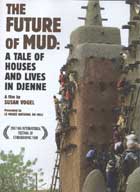
The Future of Mud: A Tale of Houses and Lives in Djenne 2006
Distributed by First Run/Icarus Films, 32 Court St., 21st Floor, Brooklyn, NY 11201; 800-876-1710
Produced by Susan Vogel, Samuel Sidibé
Directed by Susan Vogel
DVD, color, 58 min.
Jr. High - Adult
African Studies, Architecture, Sociology
Date Entered: 01/14/2008
Reviewed by Janis Tyhurst, Reference Librarian, George Fox UniversityThe producers, in conjunction with the National Museum of Mali, have created a constructed documentary that weaves the history of the Djenne mosque and the effects of modernization on the culture of Djenne, intertwining it with the daily life of a mason and his family. This documentary highlights the tension between the old and new. Whether it is architecture or education, long held traditions are being challenged. This is just one place in Africa, but the issue of old versus new ways of doing things remains the same across Africa.
Djenne has been declared a UNESCO World Heritage Monument because of its unique architecture. The effect of this designation is that the people of Djenne are not supposed to change in any way the exterior architecture of their unique mud mansions. While other towns can use cement and paint, Djenne residents cannot use either on the exterior of their homes. This creates some conflict as the surrounding areas modernize without restrictions. In 1996, there were no cars or televisions in Djenne and only a few mopeds. Today there are cars, TVs, Internet cafés and air conditioning. But these modernizations need to blend in with the traditional architecture.
The traditional mud houses are two stories high and built around a courtyard. This courtyard is the main living space where the food is prepared and cooked, and hand work such as spinning or beading is done. These houses need constant maintenance. Every family has a mason who is responsible for the care of the house. The mason is on call 24/7 for maintenance problems. The profession of masonry is frequently passed from father to son and dates back to the 13th Century. Masons have special secret rituals to bless and protect the residents of the buildings that are still practiced today. The mason is the person who digs the grave and buries the homeowners when they die, and the mason has the final say in any real estate transaction.
Woven into the history of the mud buildings is the story of a mason, Komusa Tenapo and his family. Komusa learned masonry from his father, who is still doing masonry work in his 60s. The documentary follows Komusa around as he works on various buildings while showing the choices facing him as he decides whether to have his son, Souleyman, follow in his footsteps as a mason or let him go with Asatou, Komusa’s sister, back to Bamako for more education. Asatou does not have children and offers to pay Souleyman’s school fees. Souleyman would rather be a pharmacist than a mason. In the end, Komusa allows Souleyman to go to Bamako and tells his young hired assistant, Amadou Touré, that he will be his apprentice. This part of the documentary is the constructed part, as Asatou and Souleyman are not really members of Komusa’s family, but their roles have been scripted to show the impact of modernization—the tension between passing on an apprenticeship and tradition to a family member against the value of a school education and a different career choice.
The final thread is the history, use and maintenance of the Great Mosque of Djenne. Interviews with Baba Kubarata, a Koranic teacher at the Mosque, present his views on the past and present importance of the Koran in Djenne. The annual festival where the Mosque is re-mudded is shown in detail.
This documentary has good cinematography, an excellent soundtrack and a fairly cohesive story line. It provides a current look at West African life today, the mix of the old—women in Djenne still cooking over fires—with the new—Asatou living in Bamako and owning her own business, definitely NOT cooking over a fire. Other scenes show a traditional African market held near the Mosque, methods of brick making and traditional masonry techniques and part of the masonry ritual for blessing a building.